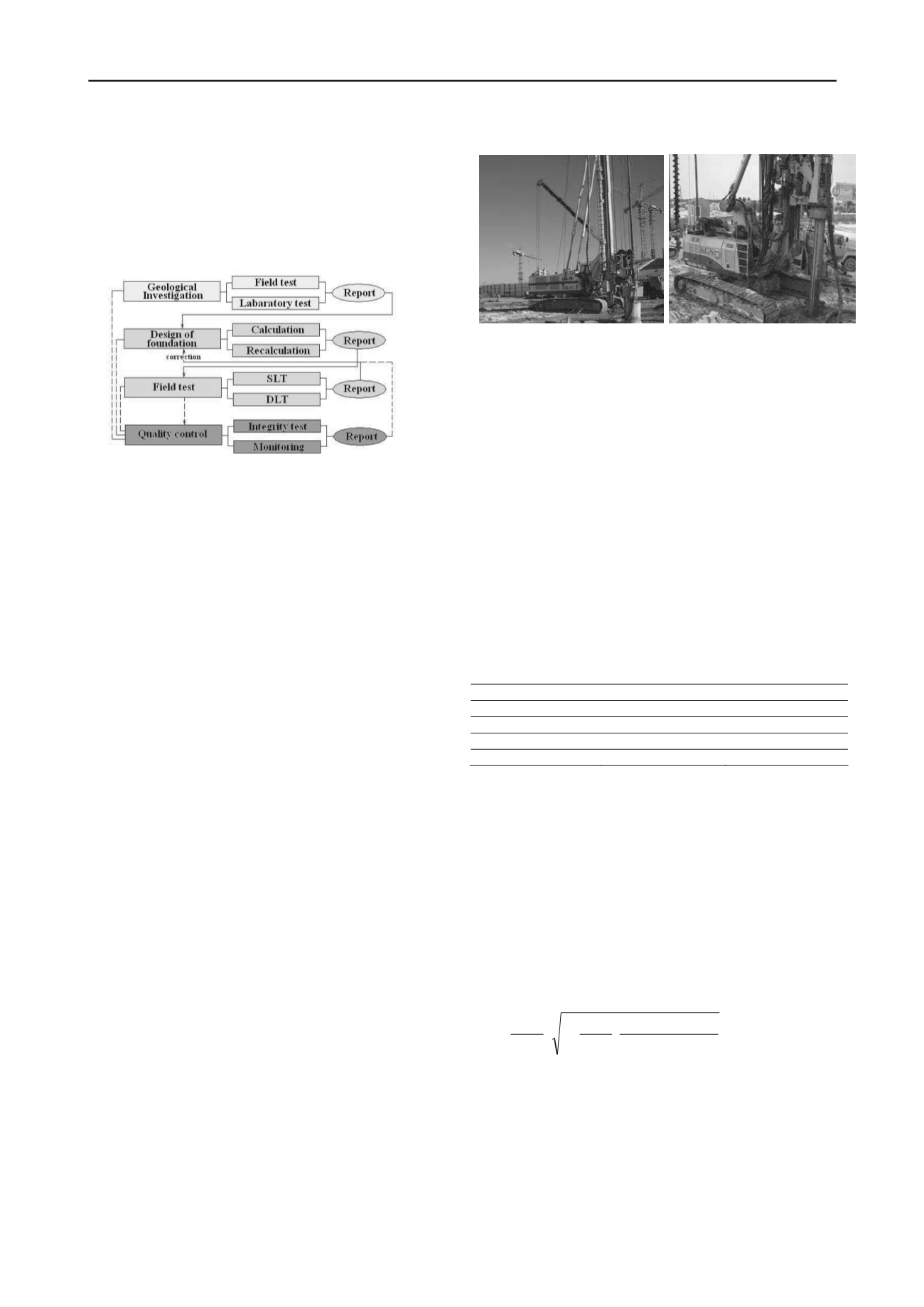
3150
Proceedings of the 18
th
International Conference on Soil Mechanics and Geotechnical Engineering, Paris 2013
1
4 1
2
2
1
3
2
2
1
mmm
mm m
AS
E
AM F
d
u
3
a
modern geoengineering requirements. The preliminary design is
performed based on the engineering and geological
investigation of construction site. Accuracy of pile design
generally depends on the accuracy of data presented in
geological report. Final pile design project is corrected after
approval by field tests. Nowadays conception of pile foundation
Figure 2.
Figure 2. Pile foundation design concept
2 FEATURES OF NEW PILE TECHNOLOGIES
The DDS technology was established by Germany Company
BAUER and undoubtedly presents practical values on
Kazakhstan construction sites. The general advantages of this
technology (comparing with traditional boring pile technology)
are: fast installation of pile, economical efficiency, low noise
during installation, absence of vibration, and high value of
bearing capacity (Sultanov G.A. 2010).
Installation of DDS pile consists of four steps, as described
below: place the boring machine to the boring place; bore the
pile hole to the design level; fill the concrete under a pressure of
300 kPa; install the steel anchor into the pile body.
The principal feature of this technology is a special boring
element. The pile hole is formed via two stages: during the
moving down of boring element, the bullet teeth loosen the soil
and the stabilizer displaces surrounding soil. During the moving
up of boring element, the secondary compaction of hole takes
place.
DDS technology allows installation of the pile up to
1200mm of diameter and 30m of length. During DDS pile
design, it is required to take into account following parameters:
diameter of pile, torque moment, indentation forces, density
(strength, compaction of soil and power of concrete pump).
A CFA pile is a type of drilled foundation in which the pile
is drilled to the final depth in one continuous process using a
continuous flight auger. The use of the continuous flight auger
rig avoids many of the problems of drilling and concreting piles
experienced when using conventional power augers. The new
CFA equipment can perform piles in most type of soils
(including sand, gravel, silt, clay, chalk and weak weathered
rock) with diameters up to 1200 mm and lengths down to 35-40
meters. So, with proper planning and design, performing
equipment and skilled personnel, high production rates and high
quality product can be achieved (Ashkey Y. 2008).
Installation of CFA pile consist of following steps: placing
the boring machine to the boring place; boring the pile hole to
the design level; removing the screw with simultaneous
concrete filling under the high pressure and replace the boring
machine, installation of steel anchor into the pile body with
preparation of pile head.
The high quality of piles is ensured by not soil extraction for
DDS and by high filling pressure for CFA.
Figure 3. New pile technologies
To analyze the bearing capacities obtained by SLT, the
calculation of design bearing capacity by Kazakhstan Standards
was performed by SNIP PK 5.01.01-2002. The classically
bearing capacity is subdivided into two constituents: shaft and
tip resistance. In Kazakhstan’s Standard, the classical equation
was modified and presented by following equation:
)
(
i i
cf
cR c
d
hf
u RA
F
(1)
where γ
c
= safety factor; γ
cR
and γ
cf
= coefficients of soil
work condition under the pile tip and around the pile,
respectively.
Unfortunately, existing Kazakhstan Standards do not take
into account soil compaction under the high concrete pressure in
case of CFA technology and soil displacement without
excavation in case of DDS technology that lead to reduction of
settlement and increase in bearing capacities of pile foundation.
Therefore it had been suggested to use following coefficients of
soil working condition as presented in Table 1.
Table 1. Suggested coefficient of soil works for DDS and CFA piles
3 TESTING OF PILE FOUNDATION
Many static and dynamic load tests were performed on this
construction site. The SLT one of the more reliable field tests in
analyzing pile bearing capacity in Kazakhstan. DLT is a fast
bearing capacity analysis field test and give more or less reliable
value of pile bearing capacity.
Dynamic load test (DLT)
. For definition of the bearing
capacities of piles, it is required to use average refusal which are
obtained during redriving of the piles after their "rest". The rest
time depend on soil condition of site: for clayey soil 6 -10 days,
for sandy and gravel soils up to 3 days.
Bearing capacity of the piles is defined by following
empirical equation:
(2)
where η=factor, dependent on concrete strength of the piles;
А=cross section of tested pile; М=1 – factor, dependent on pile
driving hammer’s impact; Е
d
=effective energy of blows of the
hammer, kNm.
According to Kazakhstan Standard at least 6 piles must be
tested by DLT on each construction site.
Static Load Test (SLT)
. SLT one of the more reliable field
tests in analyzing pile bearing capacity. SLT should be carried
out for driving piles after the “rest” and for bored piles after
achievements of the concrete strength, by more than 80%.
According to requirements of Kazakhstan Standard - SNiP
RK 5.01-03-2002 (SNiP RK 2002) – ultimate value of
Type of pile
Y
cR
Y
cf
Driving Pile
1,0
1,0
Boring Pile
0,7-1,0
0,7
DDS (FDP) Pile
1,3
1,0
CFA Pile
1,0
1,0


